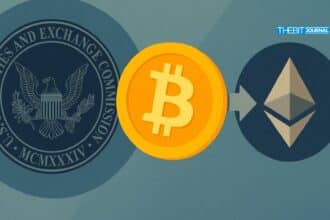Chainlink’s co-founder Sergey Nazarov has aired that the incoming wave of U.S. stablecoin regulation will usher in global stablecoin growth, setting grounds for transparency, compliance, and blockchain interoperability. Speaking recently on X, Nazarov said this regulatory clarity will not only unlock a flood of new stablecoin issuers but also sharply raise the bar for how these digital assets must operate within global financial systems.
As these rules move toward implementation, Nazarov said stablecoins can no longer survive on branding or marketing alone. Instead, they will need to meet tougher demands for real-time asset backing, seamless cross-chain utility, and robust on-chain compliance.
Chainlink, according to him, is preparing to meet this transformation head-on by becoming the default infrastructure layer supporting it.
Proof-of-Reserves and Cross-Chain Support Becomes Critical in New Stablecoin Era
At the heart of Chainlink’s strategy is its Proof of Reserves (PoR) oracle system which provides cryptographically verified attestations that a stablecoin is backed 1:1 by underlying reserves.
As regulators demand real-time proof of collateral, this infrastructure has become essential. Unlike self-reported figures or delayed audits, PoR feeds data directly from custodians into smart contracts so users; regulators and partners can independently verify if a stablecoin is fully backed.
But Nazarov said transparency won’t be enough. As the stablecoin ecosystem goes global, assets must move freely across multiple chains supporting use cases for DeFi, tokenized treasuries, cross-border payments and institutional settlement layers.

Chainlink’s Cross-Chain Interoperability Protocol (CCIP) addresses this by providing secure messaging and token transfer between chains. Launched in mid-2023 and already integrated by players like SWIFT and ANZ, CCIP allows stablecoins to scale beyond isolated blockchain ecosystems.
Nazarov said many stablecoin projects will struggle to meet both transparency and connectivity standards at the same time, especially under regulatory scrutiny. This he argued creates a competitive advantage for Chainlink which offers a unified solution for asset backing verification and cross-chain mobility in one integration.
Compliance and Identity Will Be the Next Phase of Stablecoin Regulation
Nazarov said regulation won’t stop at reserves or chain compatibility. He expects a new phase of on-chain compliance requirements that will demand identity verification, Know Your Customer (KYC) and auditable transaction history to be embedded in the blockchain itself.
To meet this, Chainlink is building infrastructure that goes beyond data and connectivity. Its new identity modules will allow stablecoin issuers and institutions to layer verifiable credentials and compliance logic into smart contracts.
According to Nazarov the goal is to make Chainlink the first platform to offer an integrated stack of reserves, cross-chain functionality, identity and on-chain compliance; all in one secure, programmable environment.
Simplifying Complex Blockchain Systems with Unified Infrastructure
As stablecoins become mainstream, Nazarov believes complexity will be the biggest threat to adoption. Institutions won’t adopt systems that require stitching together multiple fragmented services, especially when those systems handle real money. Chainlink’s vision is to simplify blockchain operations by offering a single interface for all critical infrastructure; reserves tracking, identity, cross-chain messaging and compliance enforcement.
According to Nazarov, this one-code integration model allows developers and institutions to reduce implementation time, lower security risks and meet regulatory requirements without needing separate middleware providers.
With financial compliance getting more and more stringent, this simplicity may be the key to which stablecoins and infrastructure providers will survive long term.
Stablecoins Will Be the Core Settlement Layer of a Tokenized Economy
Industry experts agree that stablecoins are becoming the base layer of a tokenized economy. From remittances to decentralized trading, stablecoins are already the dominant unit of account on blockchain networks. With billions in daily trading volume and growing demand for programmable money, their influence will only grow.
But as regulation catches up, the requirements around operational transparency and financial disclosure will increase. Chainlink’s oracle infrastructure and regulatory aware development puts it in a great position to service that demand.

Institutions looking to issue or manage stablecoins will need providers that support technical execution and compliance architecture to withstand regulatory scrutiny.
Chainlink Eyes Dominance as Regulated Stablecoin Infrastructure
As U.S. stablecoin regulation moves from theory to reality; market participants are rethinking what infrastructure will be needed to comply and scale.
Chainlink; already in dozens of DeFi protocols and financial pilots; is positioning itself for the forefront of that conversation. Its integrated stack; proof-of-reserves, cross-chain, and compliance tooling; could be the standard for new stablecoin issuers and financial institutions alike.
Nazarov’s comments make it clear Chainlink is building towards that future where it’s the backbone for compliant, scalable, and secure digital money.
FAQ
What does Chainlink offer stablecoin issuers?
Chainlink offers a unified infrastructure that includes real-time proof-of-reserves; cross-chain messaging; identity verification and compliance tooling for regulated stablecoin deployment.
How does Chainlink’s Proof-of-Reserves work?
Proof-of-Reserves is a decentralized oracle service that verifies in real time that a stablecoin or token is fully backed by its claimed reserves; so users and regulators can trust and verify.
What is CCIP and why is it important?
Chainlink’s Cross-Chain Interoperability Protocol (CCIP) enables secure token and data transfers across multiple blockchains; as stablecoins will increasingly need to operate in multi-chain environments.
Why is regulation a growth driver for Chainlink?
As regulators demand more transparency and compliance from stablecoin issuers; Chainlink’s infrastructure provides the tools to meet those standards; so it’s a key enabler of future stablecoin growth.
Glossary
Stablecoin: digital currency pegged to a stable asset like the US dollar, used for transactions and value storage.
Proof-of-Reserves (PoR): way to verify if an asset is fully backed by collateral, powered by oracles.
Cross-Chain Interoperability (CCIP): tech that allows digital assets and data to move across different blockchains.
On-chain Compliance: ways to embed regulatory requirements like identity verification or transaction audits into smart contracts.
Tokenization: process of converting real-world assets like stocks; bonds, or property into digital tokens on a blockchain.
Sources





























